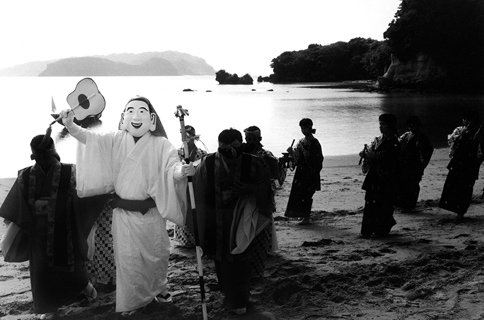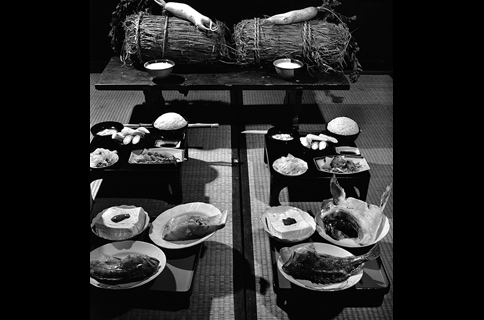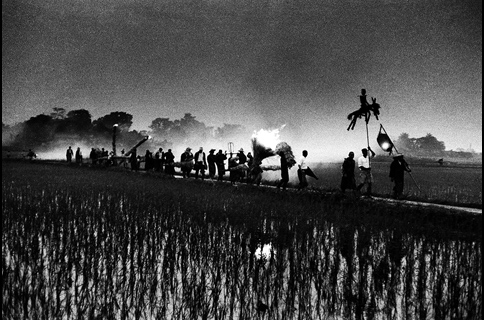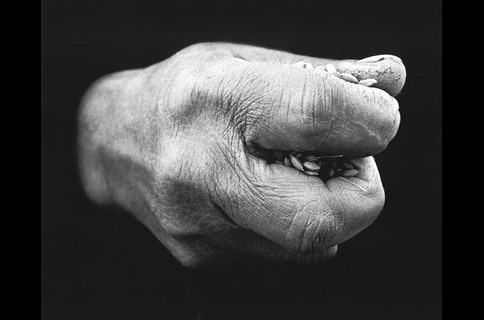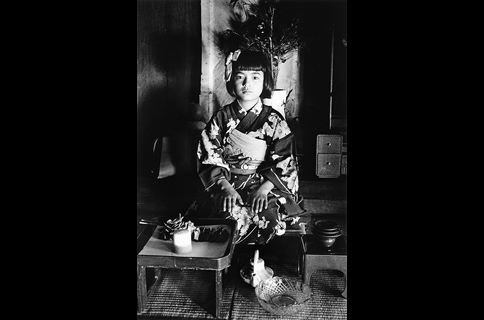- Home
- Exhibitions & Events
- Things we have to treasure, Things we have to share Selected Works by Haga Hideo, Great Master of Folklore Photography
Photo History Museum FUJIFILM SQUARE
Things we have to treasure, Things we have to share
Selected Works by Haga Hideo, Great Master of Folklore Photography
The Photo History Museum at FUJIFILM SQUARE is pleased to announce the photo exhibition “Things we have to treasure, Things we have to share Selected Works by Haga Hideo, Great Master of Folklore Photography ” which runs from January 4 — March 31, 2018.
Throughout his lifetime, Haga Hideo has portrayed various festivals around the world and established what is now known as the genre of “folklore photography”. This exhibition will show 30 finely selected works from the over 400,000 photographs that constitute the body of Haga's oeuvre, focusing on what is considered to be the point of departure of his artistic practice: His early photographs of rice farming rituals and other traditional Japanese customs.
For over 60 years now, Haga Hideo has continued to photograph traditional festivals and annual ceremonies throughout Japan and the world. Underpinned by Haga's own unique philosophical conception of folklore, these photographs transgress the narrow boundaries of documentary photography and have become the prototype of a new artistic genre, the genre of “folklore photography”.
Haga Hideo was born in Dairen (the present city of Dalian), China in 1921. When he came to Japan for the first time around the age of 18 in order to take the college entrance examination, he was overwhelmed by the country's rich nature and the aesthetic pleasures it enables. Plum and cherry trees blossoming in the warm spring sun was a sight that made a lasting impact on the young Haga and fostered his artistic sensibility.
After successfully entering Keio University, Haga — who already from the time he was in primary school had taken photographs — under the guidance of his father became a member of photographic circles and began to immerse himself into photography. A lecture by ethnologist Orikuchi Shinobu opened his eyes to the study of folklore and led him to travel through Japan to photograph the various annual celebrations and festivities throughout the country after graduation. In 1959, he published a selection of photographs of rice farming rituals under the title “Ta no kami” (Gods of the Rice Fields). He continued his work of depicting local customs and festivals, becoming one of the first photographers of Japanese folklore and although his work was still rather unknown back then, he was appointed the curator of the “Festival Square” at the Expo 1970 in Osaka. This exhibition will show 30 works from the period prior to this appointment, giving an insight into the early work of Japan's first folklore photographer.
“This rich spiritual culture of different prayers for different season is what characterized the Japanese people.(...) What I want you to see is, that despite undoubtedly having its benefits, we also have lost a lot during the process of enlightenment. Traditional festivals, for instance. And many of these festivals are an expression of the ordinary people's wishes, cries, and gratitude.”
(Haga Hideo “Sashin Minzoku-gaku”, 2017)
Haga's work of portraying ordinary Japanese people in their continuous interaction with the countless gods inhabiting their surroundings through the practice of traditional festivals allows us to rethink how our present might be traceable to the past, a past that when re-encountered might enrich our present.
Artist Profile HAGA Hideo
Haga was born in 1921, Dalian, China. He graduated from Keio University's with a degree in Literature in 1944. In 1946 he joined the Nippon Telecommunications Company. In 1950, he became one of the founding members of the Japan Professional Photographers Association. In 1970, he curated the “Festival Square” at the Expo 70' in Osaka.
He received various awards, including the Distinguished Service Award by the City of Vienna, Austria in 1988, the Medal of Honor with Purple Ribbon in 1989 and the Order of the Rising Sun 4th Class in 1995 by the Japanese Government as well as the Lifetime Achievement Award by the Photographic Society of Japan in 1997 and the Decoration for Science and Art by the Republic of Austria in 2009. Major works include “Ta no Kami — The Rituals of Rice Production in Japan” (Heibonsha, 1959), “Japanese Festivals” (Hoikusha, 1991), “Folklore of Japan” (Creo, 1997), “Traveling through the old times with Orikuchi Shinobu” (Keio University Press, 2009) and “Photographic Ethnography — The Gods of the East and West” (Kadokawa, 2017). He also held numerous exhibitions, including “Ta no Kami” at Tokyo's Konishiroku (Konika) Gallery in 1958 or “The Rhythm of Life and Death in Japan” at the Keio University Art Center in 1995.
| Title | Things we have to treasure, Things we have to share Selected Works by Haga Hideo, Great Master of Folklore Photography |
|---|---|
| Period | January 4, 2018 (Thu.) — March 31, 2018 (Sat.) Open every day from 10:00-19:00 (last admission 18:50) |
| Number of works | approx. 30 |
| Venue | The Photo History Museum at FUJIFILM SQUARE |
| Admissions | Free |
| Organization | FUJIFILM Corporation |
| Cooperation | HAGA Library |
| Collaboration | The Minato-ku Board of Education |
| Planning and Production | Contact Co., Ltd. |
Events during the exhibition
Gallery Talk by Haga Hideo and Haga Hinata.
| Date | February 3, 2018 (Sat.) and March 3 (Sat.), 2018 14:00-14:30 |
|---|---|
| Venue | The Photo History Museum at FUJIFILM SQUARE |
| Admissions | Free * No registration required * No seats available |
Events during the exhibition
Gallery Talk by Haga Hinata.
| Date | March 10 (Sat.), 2018 14:00-14:30 / 16:00-16:30 |
|---|---|
| Venue | The Photo History Museum at FUJIFILM SQUARE |
| Admissions | Free * No registration required * No seats available |
In 2017, the Photo History Museum was formally approved by the Association for Corporate Support of the Arts for its “contributions to society through the promotion of arts and culture” and was permitted to use the official “This is MECENAT 2017” mark.

